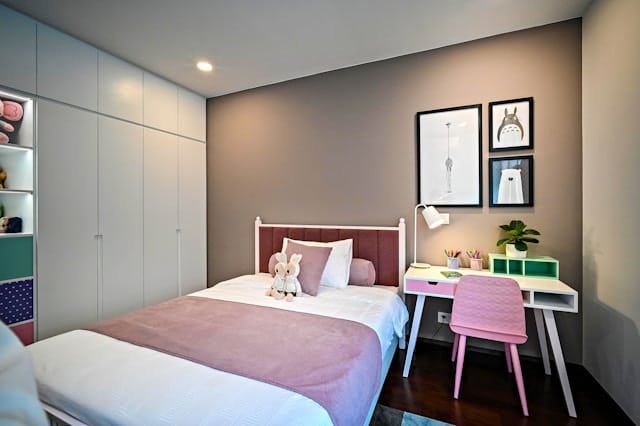What’s the Best Approach to Childproofing an Open Plan Living Space Without Compromising on Design?

Childproofing your living space is one of the most crucial steps you’ll take when you welcome a baby into your world. It’s about creating a safe environment where your child can explore, play, and learn without risk of injury. Yet, how can you ensure safety without compromising the aesthetics of your open-plan living space? Let’s delve into the best strategies to balance child safety and great design in an open plan living space.
Understanding Potential Dangers
The first step toward childproofing your home is understanding the potential dangers that lurk in ordinary furniture and objects.
En parallèle : What’s the Best Method to Waterproof a Basement Recreation Room?
Many of the items you take for granted in your home can pose a risk to curious children. From the sharp corners of a coffee table to the cords of window blinds, hazards can be found even in seemingly benign objects. It’s essential to see your space from a child’s perspective to identify these potential dangers. Once you know what to look out for, you can take appropriate measures to mitigate these risks without affecting your home’s design.
Furniture can be a significant hazard. It’s vital to secure heavy furniture that could potentially tip over, like bookcases and televisions. Furniture corners can also pose a risk, but corner protectors can keep children safe without detracting from your home’s overall aesthetic.
Cela peut vous intéresser : How to Create a DIY Rooftop Garden for Urban Agriculture?
Cords can be enticing to children, but they can cause accidents if pulled or tugged on. Choose cordless window treatments or ensure cords are well hidden and out of reach.
Childproofing Electrical Outlets and Cords
Electrical outlets and cords are often at child-height, making them an irresistible attraction for little hands. Here are some ways to ensure they are secure.
Childproof electrical covers are an effective way to prevent children from sticking fingers or objects into the socket. Look for covers that blend with your wall color to maintain a cohesive design.
When it comes to cords, consider cord management systems that keep cords hidden and out of reach. This not only contributes to childproofing but also gives your space a cleaner, more organized look.
Creating Safe Spaces with Furniture Arrangement and Baby Gates
Your furniture arrangement plays an essential role in creating a child-proofed, open-plan living space.
Strategically placing furniture can create barriers to certain areas or make potentially dangerous items out of reach. For example, placing a couch in front of a bookshelf can prevent a child from climbing it, or positioning a coffee table away from a walkway can prevent bumping into corners.
Baby gates play a fundamental role in childproofing, and fortunately, many stylish options will suit your home’s design. Look for gates that blend with your home’s architecture or add a design element, like a pop of color or visual interest.
Safety Locks and Latches – Hidden Safety
The use of safety locks and latches is another effective means of childproofing your open plan living space.
Cabinets, drawers, and some appliances can be made childproof with the use of safety locks and latches. These are typically easy to install and are almost invisible, maintaining the design integrity of your space.
Choose locks that are easy for adults to operate but difficult for children. As the child grows and develops more skill, make sure you adjust or upgrade the locks as needed.
Making Safety a Design Element
Safety doesn’t have to be an afterthought or merely practical. Instead, make it an integral part of your design plan.
Consider your childproofing measures as you would any other design element. For example, use colorful corner protectors that add to your design scheme, or use stylish baskets to store toys and prevent tripping hazards.
In an open-plan living space, one approach is to create a dedicated and attractively designed child-friendly zone. This space can be outfitted with child-safe furnishings and storage, freeing up the rest of the space for adult use while also adding a playful design element.
Remember, balancing child safety and design in an open-plan living space is not only possible but can also be an opportunity for creative, thoughtful design. You can create a space that’s both stylish and safe for your child to grow and explore.
Incorporating Safety Products for Comprehensive Childproofing
Childproofing is a meticulous process which involves covering every corner of your open plan living space. Safety products can assist in achieving a thorough childproof environment without undermining your space’s aesthetic appeal.
One effective product is outlet covers. Electrical outlets are intriguing for young children, but they pose a substantial hazard. Opt for outlet covers that blend with the wall color to maintain harmony in your design.
Similarly, furniture and appliances with sharp edges can be a danger zone for toddlers. Safety products such as edge guards can be used to soften sharp edges, and they come in different colors and materials to match your furniture seamlessly.
Small objects are another potential hazard, as they can easily be swallowed by young children. A good solution is to use attractive storage boxes or baskets that complement your living room decor, where these objects can be safely stored.
Another crucial aspect is the protection of your television or other standing appliances. Anti-tip straps are effective in securing them and preventing any topple-over accidents. These are typically installed at the back and are thus invisible, preserving your living room’s design.
In essence, the multitude of safety products available on the market can aid in baby proofing your space effectively while maintaining its aesthetic value.
Conclusion: Balancing Child Safety and Design in an Open Plan Living Space
Child proofing an open plan living space may seem daunting initially. However, with careful planning and a keen eye for potential hazards, it is achievable without having to compromise on your aesthetic preferences.
Remember, the goal is to create an environment where your child can safely explore and learn. This involves identifying the potential hazards, whether they are furniture appliances, electrical cords, small objects, or sharp edges. Once you’ve recognized these risks, you can implement proofing measures using a variety of safety products and strategies.
Safety gates, outlet covers, cord management systems, safety locks and latches, and strategic furniture arrangement are just a few examples of how you can create a safe environment. It’s important to note that many of these safety measures can be seamlessly integrated into your design plan, either by being virtually invisible or by adding a unique design element to your space.
Finally, always remember to keep pace with your growing child. As they develop and learn new skills, new hazards may emerge. Always stay one step ahead: review your child-proof living space regularly, adjust existing safety measures, and find new ones as needed.
In conclusion, an open plan living space doesn’t have to be a hindrance to child safety. On the contrary, with careful planning and the right strategies, you can create a beautifully designed, child-proof haven for your little ones to grow and thrive. Remember, child safety and great design can, and should, go hand in hand.
